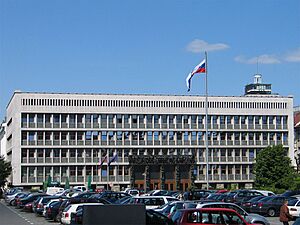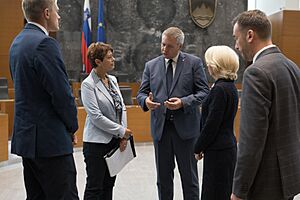National Assembly (Slovenia) facts for kids
Quick facts for kids National Assembly of the Republic of SloveniaDržavni zbor Republike Slovenije |
|
|---|---|
| 9th National Assembly | |
 |
|
| Type | |
| Type |
Lower house
|
| Leadership | |
|
Speaker
|
Urška Klakočar Zupančič, GS
Since 13 May 2022 |
| Structure | |
| Seats | 90 |
 |
|
|
Political groups
|
Government (50)
Supported by (2)
Opposition (38)
|
| Elections | |
| Open list proportional representation with a 4% election threshold | |
|
Last election
|
24 April 2022 |
|
Next election
|
On or before 24 April 2026 |
| Meeting place | |
| National Assembly Building, Ljubljana | |
| Website | |
| https://www.dz-rs.si | |
The National Assembly (called Državni zbor Republike Slovenije in Slovenian) is the main group of elected representatives in Slovenia. It is a very important part of the Slovenian Parliament, which makes laws for the country. The National Assembly has 90 members, also called MPs, who are chosen by the people for a four-year period.
Most of the 88 members are elected using a system where people vote for parties, and seats are given based on how many votes each party gets. The other two members are chosen by the Hungarian and Italian-speaking minority groups. These two members have a special power to stop laws that affect their communities.
As of May 2022, the 9th National Assembly of Slovenia is working.
Contents
How Laws Are Made
Making a new law in the National Assembly follows a set of steps. This process is called the legislative procedure.
Who Can Suggest a Law?
A new law can be suggested by a few different groups:
- The Government of Slovenia.
- Any member of the National Assembly (an MP).
- The National Council, which is another part of the Slovenian Parliament.
- At least 5,000 voters.
Once a bill (a proposed law) is submitted, the Speaker of the National Assembly shares it with all the MPs.
Types of Lawmaking Procedures
There are three main ways a bill can become a law:
- Regular legislative procedure (the usual way).
- Abbreviated legislative procedure (a quicker way for simpler laws).
- Urgent legislative procedure (for very important or emergency laws).
Most laws are passed if more than half of the MPs present vote for them. However, for some very important laws, like those about elections or changing the Constitution, at least 60 out of the 90 MPs must vote yes.
Regular Lawmaking Steps
The regular way to make a law has three main steps:
First Reading
The first reading usually happens when the Speaker gives the bill to the MPs. Sometimes, if ten MPs ask for it, they will have a special meeting to talk about why the bill was suggested. If this meeting happens, the Assembly votes on whether the bill should continue to the next steps. The Speaker then chooses a special group, called a working body, to discuss the bill in more detail.
Second Reading
During the second reading, the working body carefully discusses the bill. They can make changes to it. They then create a report about the bill, which is used for the main meeting of the Assembly. The working body discusses and votes on each part of the bill. Later, the full Assembly only discusses and votes on the parts that were changed by the working body. Both the Assembly and the working body can decide that the bill is not good enough to continue.
Third Reading
In the third reading, the working body and the full Assembly vote on the entire bill. If it is approved, the bill is sent to the President of Slovenia to sign it. Once signed, it becomes a law.
Shortened Lawmaking Steps
This procedure is faster because it skips the first reading. The second and third readings happen during the same meeting. This method is used for bills that:
- Deal with small or simple matters.
- Cancel another law.
- Need to match Slovenian laws with European Union rules.
- Change how the Constitutional Court works.
Urgent Lawmaking Steps
This is the fastest way to pass a law. It is used only for very important situations, such as:
- Matters related to the country's safety or defense.
- Dealing with the effects of natural disasters.
- Preventing serious problems for the country.
Like the shortened procedure, there is no first reading, and the second and third readings happen in the same meeting. Changes to the bill can even be suggested verbally, and the whole process is much quicker.
Stopping a Law: The Veto
After a bill is passed by the National Assembly, the National Council (the other part of the Slovenian Parliament) can stop it. They have two weeks to do this. If they stop it, the National Assembly can still make it a law if more than half of all its members vote for it again. This is called overriding the veto.
Leaders of the National Assembly
The Speaker is like the president of the National Assembly. They lead the meetings and make sure everything runs smoothly. Here are some of the people who have been Speaker:
- France Bučar: 1990 – 1992
- Herman Rigelnik: 1992 – 1994
- Jožef Školč: 1994 – 1996
- Janez Podobnik: 1996 – 2000
- Borut Pahor: 2000 – 2004
- Feri Horvat: 2004
- France Cukjati: 2004 – 2008
- Pavel Gantar: 2008 – 2011
- Ljubo Germič: 2011
- Gregor Virant: 2011 – 2013
- Janko Veber: 2013 – 2014
- Milan Brglez: 2014 – 2018
- Matej Tonin: 2018
- Dejan Židan: 2018 – 2020
- Igor Zorčič: 2020 – 2022
- Urška Klakočar Zupančič: 2022 – (current Speaker)
How Members Are Elected
The 90 members of the National Assembly are chosen in two main ways.
Electing Most Members
Most of the 88 members are elected using a system called open list proportional representation. This means that Slovenia is divided into eight large areas, and each area elects 11 members. People vote for a party, and the seats are given to parties based on the percentage of votes they get. Voters can also show which candidates they prefer within a party's list.
To make sure different genders are represented, parties must have at least 35% of their candidates from each gender on their lists, unless they only have three candidates, in which case at least one must be of each gender.
Electing Minority Representatives
Two extra members are elected to represent the Italian and Hungarian minority groups. Voters in these communities rank all the candidates on their ballot paper. The candidate who gets the most points (based on how voters rank them) wins.
Latest Election Results
Images for kids
See also
 In Spanish: Asamblea Nacional de Eslovenia para niños
In Spanish: Asamblea Nacional de Eslovenia para niños






